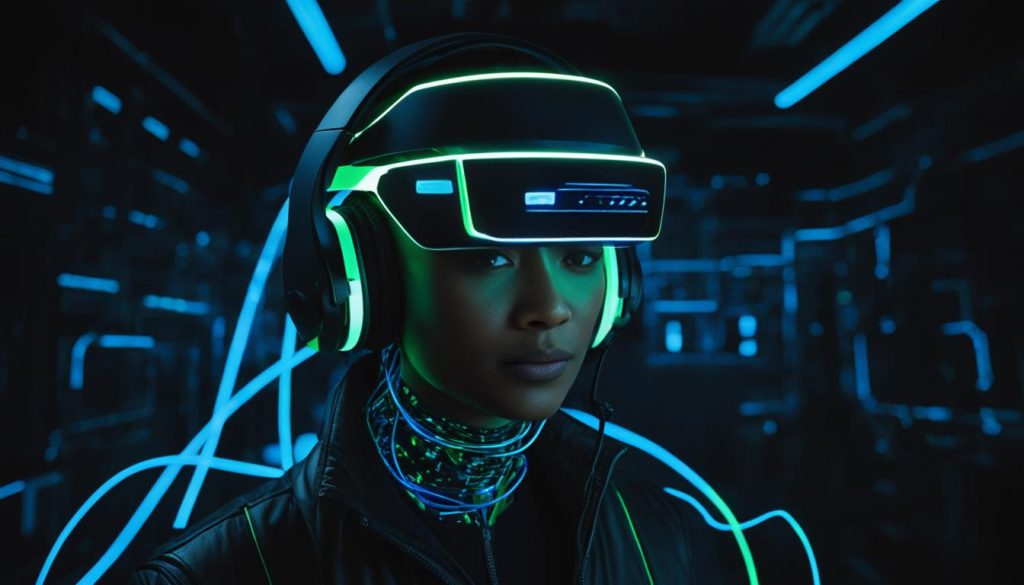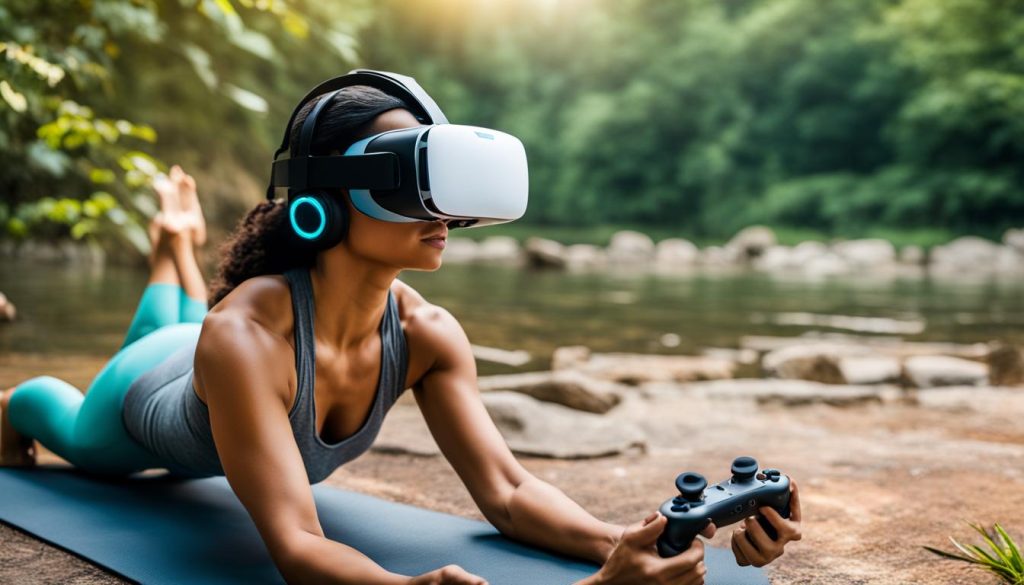Virtual Reality (VR) is revolutionizing various industries and transforming the way we experience entertainment, education, and more. With its immersive nature and technological advancements, VR gaming has become a prominent force in the world of gaming. Beyond gaming, VR is finding its way into the realm of education, offering new and exciting educational uses. In this article, we will explore the rise of virtual reality, with a particular focus on VR gaming, its educational potential, and the latest technology trends shaping the future of this immersive medium.
Key Takeaways:
- Virtual Reality (VR) is revolutionizing various industries, including gaming and education.
- VR gaming offers immersive experiences, enhanced by technologies such as haptic feedback and VR treadmills.
- Advancements in VR technology, including high-resolution displays and accurate head-tracking, contribute to realistic and lifelike virtual environments.
- Multiplayer VR games allow for social interaction, creating shared virtual spaces.
- VR gaming has also found applications in health and fitness, as well as in education and training.
The Genesis of VR Gaming
Virtual Reality (VR) gaming has come a long way since its early beginnings in the 1960s and 70s. It wasn’t until the 21st century that VR technology became sophisticated enough to capture the attention of the mainstream gaming market. This section explores how the introduction of head-mounted displays (HMDs) and motion-tracking technology revolutionized immersive gameplay, transporting players into virtual worlds unlike anything they had experienced before.
In the early days of VR gaming, players were limited to rudimentary graphics and basic interactions. The technology was far from the immersive gameplay we know today. However, as computer processing power increased and VR hardware became more advanced, developers were able to create more captivating and realistic virtual environments.
“VR gaming has the potential to transport players into fantastical worlds, allowing them to become fully immersed in a digital reality. The introduction of head-mounted displays and motion-tracking technology has played a crucial role in transforming gaming experiences.”
The breakthrough came with the introduction of head-mounted displays (HMDs), such as the Oculus Rift and HTC Vive, which offered high-resolution screens and a wide field of view. These devices allowed players to wear the VR headset and have their movements tracked, creating a sense of presence and immersion within the virtual world.
Additionally, motion-tracking technology, like the controllers and sensors used in VR systems, enabled players to interact with objects and manipulate the virtual environment through intuitive gestures. This level of interactivity further deepened the immersive experience, making players feel like they were an integral part of the virtual world.
Let’s take a closer look at the key components that contributed to the rise of VR gaming:
Head-Mounted Displays (HMDs)
Head-mounted displays, or VR headsets, are the gateway to immersive gameplay in the world of virtual reality. These devices encompass the eyes and ears of the player, transporting them to a digital realm where they can explore and interact with the environment. Notable examples of VR headsets include the Oculus Rift, HTC Vive, and PlayStation VR.
Motion-Tracking Technology
Motion-tracking technology allows players to seamlessly integrate their movements into the virtual world. By wearing motion-tracked controllers or using external sensors, players can have their real-life actions mirrored in the virtual environment. This technology enhances the sense of presence and empowers players to interact with objects and characters in a more intuitive and natural way.
As VR technology continues to evolve, we can expect even more immersive gameplay experiences that blur the line between the physical and virtual worlds. The advancements in head-mounted displays and motion-tracking technology have set the stage for an exciting future of virtual reality gaming.
Now, let’s move on to the next section to explore how VR gaming is transforming the player experience.
Transforming Player Experience
The core appeal of VR gaming lies in its immersive nature. Players are no longer passive observers but active participants in virtual worlds. Through the use of haptic feedback suits and VR treadmills, players can engage with the digital environment on a whole new level, enhancing their physical experience.
With haptic feedback technology, players receive tactile sensations that mimic real-world touch, creating a more sensory and realistic experience. Whether it’s the impact of a punch in a boxing game or the sensation of texture in a virtual object, haptic feedback adds a layer of immersion that goes beyond visuals and sound.
VR treadmills further amplify the active participation aspect by allowing players to move within the virtual space. These devices enable users to physically walk, run, or even jump, translating their real-world movements into the digital realm. By incorporating physical movements, VR treadmills enhance the sense of presence and embodiment within the virtual environment.
This combination of haptic feedback and VR treadmills amplifies the immersive nature of VR gaming, leading to a more engaging and captivating experience. Players can truly feel and interact with the virtual world, blurring the lines between reality and digital fiction.
Enhancing Realism: Haptic Feedback and VR Treadmills
| Haptic Feedback | VR Treadmills |
|---|---|
| Provides tactile sensations | Enables physical movement within the virtual space |
| Enhances realism and immersion | Translates real-world movements into the virtual environment |
| Allows players to feel and interact with virtual objects | Creates a sense of presence and embodiment |
Immersed in a world where their actions have consequences, players become active participants, shaping their own experiences. This shift from passive observation to active engagement adds a new dimension to gaming, unlocking possibilities for creativity, exploration, and challenge.

The Technology Behind the Scenes
VR gaming has come a long way thanks to advancements in VR technology. Modern VR headsets offer high-resolution displays, accurate head-tracking, low latency, and realistic environments, all of which contribute to a comfortable and immersive gaming experience.
One of the key elements of VR technology is the high-resolution displays found in modern headsets. These displays ensure that the virtual world appears sharp, clear, and detailed, enhancing the overall visual experience. With high pixel density, users can fully immerse themselves in vibrant and lifelike virtual environments.
Accurate head-tracking is another crucial aspect of VR technology. By accurately detecting the movement of the user’s head, VR headsets can deliver a seamless experience, making users feel like they are truly present in the virtual world. This precise head-tracking enables users to look around and interact with their surroundings, enhancing the sense of immersion and realism.
In addition to high-resolution displays and accurate head-tracking, low latency is essential for a smooth and realistic VR gaming experience. Low latency refers to the minimal delay between a user’s movements and the corresponding changes in the virtual world. By minimizing latency, VR technology ensures that users’ actions are instantly reflected in the virtual environment, reducing any lag or disorienting effects that could break the immersion.
Advancements in computer graphics and processing power have played a significant role in creating realistic and complex virtual environments. VR game developers can now create highly detailed and visually stunning worlds thanks to the increased capabilities of modern hardware. These realistic environments contribute to the overall immersive experience, making VR gaming feel more lifelike and engaging.
Comparison of VR Headsets
| VR Headset | Resolution | Field of View | Head-tracking | Refresh Rate |
|---|---|---|---|---|
| Oculus Rift S | 2560 x 1440 | 110 degrees | 6 degrees of freedom | 80 Hz |
| HTC Vive Cosmos | 2880 x 1700 | 110 degrees | 6 degrees of freedom | 90 Hz |
| PlayStation VR | 1920 x 1080 | 100 degrees | 6 degrees of freedom | 120 Hz |
| Valve Index | 2880 x 1600 | 130 degrees | 6 degrees of freedom | 144 Hz |

The Rise of Social and Multiplayer VR
Virtual Reality (VR) gaming is not limited to solitary experiences; it is also revolutionizing the social aspect of gaming. Multiplayer VR games enable players to connect and interact with each other in a shared virtual space, taking social interaction to new heights.
With the advent of multiplayer VR, players can engage with friends, family, and even strangers in virtual environments, fostering a sense of community and camaraderie. The shared virtual space allows players to interact, communicate, and collaborate, creating a new level of social interaction that transcends physical boundaries.
One notable example of a multiplayer VR game that showcases the potential of socializing and community building is ‘VRChat.’ It offers a platform where people can come together to explore virtual worlds, attend events, create avatars, and engage in lively conversations. The game blurs the line between gaming and social experiences, providing a unique space where friendships can be formed and shared experiences can be enjoyed.
Benefits of Social Interaction in VR Gaming
The rise of social and multiplayer VR gaming brings numerous benefits to players:
- Enhanced Immersion: Interacting with others in a virtual space adds a layer of realism and immersion to the gaming experience, making it more engaging and enjoyable.
- Friendship and Community Building: Multiplayer VR games offer opportunities to connect with like-minded individuals, fostering friendships and building a sense of community.
- Collaborative Gameplay: Coordinating with other players in multiplayer VR games often requires teamwork and cooperation, encouraging collaboration and strategic thinking.
- Shared Adventures: Exploring virtual worlds and overcoming challenges together creates shared memories and bonding experiences among players.
- Learning and Skill Development: Engaging with skilled players in multiplayer VR games provides an opportunity to learn from others, improve gaming skills, and discover new strategies.
In conclusion, the rise of social and multiplayer VR gaming has transformed the way players interact and connect with each other. Not limited to solo experiences, VR gaming offers a shared virtual space where social interaction flourishes. Games like ‘VRChat’ exemplify the potential of VR as a platform for socializing, community building, and enhancing the overall gaming experience.
VR Gaming and Health
VR gaming is not just about entertainment. It has ventured into the realm of health and fitness, offering unique opportunities for physical activity and rehabilitation therapy. Games specifically designed for exercise in virtual reality have gained popularity and are proving to be effective in promoting fitness and well-being.
One such game is ‘Supernatural,’ a VR fitness experience that combines high-intensity workouts with immersive gameplay. Players can engage in virtual workouts that include cardio exercises, strength training, and mindfulness routines. The game provides a fun and motivating environment that encourages physical activity and helps users stay engaged with their fitness goals.
Another popular VR fitness game is ‘BoxVR,’ which simulates a boxing workout in a virtual environment. Users can throw punches, block, and duck in response to on-screen cues, providing a challenging and engaging full-body workout. The game also offers various workout styles and music genres to suit different preferences and fitness levels.
These VR fitness games provide an interactive and engaging alternative to traditional workout routines. The immersive nature of virtual reality helps users stay motivated and adds an element of enjoyment to their fitness journey.

VR technology has also shown potential in rehabilitation therapy. It can be used to create immersive and interactive experiences that aid in the recovery process for patients with physical injuries or conditions. Virtual reality simulations can be tailored to specific rehabilitation needs and allow patients to engage in therapeutic activities in a safe and controlled environment.
For example, VR can be used to simulate real-world scenarios for patients with balance and mobility issues. By navigating virtual environments and practicing movements, patients can improve their motor skills and regain confidence in their physical abilities. VR therapy has also been explored in pain management and cognitive rehabilitation, offering innovative approaches to traditional treatment methods.
The use of VR in health and fitness and rehabilitation therapy is an exciting intersection of technology and well-being. As research and development in this field continue, we can expect further advancements that harness the power of virtual reality to enhance physical activity and improve the quality of care in rehabilitation settings.
Expanding Horizons: VR’s Role in Education and Training
Virtual Reality (VR) technology is transforming the landscape of education and training, offering immersive and interactive experiences that enhance learning outcomes. Educational institutions and companies are harnessing VR’s potential to create simulation-based training programs, providing students and professionals with practical learning experiences that were previously inaccessible.
One area where VR is making a significant impact is in the field of medicine. By simulating complex surgical procedures, medical students can gain valuable hands-on experience without the need for real-life patients. VR allows them to practice intricate surgical techniques, develop critical decision-making skills, and improve overall confidence before stepping into an operating room.
Furthermore, VR is being used to create realistic and hazardous environments for safety training in industries like oil and gas. Employees can undergo immersive training exercises that simulate emergency situations, such as fires or chemical spills, ensuring they are fully prepared to handle such incidents in real-world scenarios.
VR’s role in education extends beyond technical and industrial training. It is also revolutionizing the way we teach subjects like history, geography, and science. Students can virtually visit historical landmarks, explore distant galaxies, or dissect virtual organisms, bringing these subjects to life and fostering a deeper understanding.
VR’s interactive nature encourages active participation, critical thinking, and problem-solving skills. Students are no longer passive recipients of information but active explorers, engaging with the content in a way that traditional methods cannot replicate. This innovative approach to education not only increases student engagement but also improves retention and comprehension.
Case Study: VR in Chemistry Education
“Using VR technology in chemistry education has transformed the way students understand complex concepts. Through interactive simulations, students can visualize and manipulate chemical reactions in 3D space, enhancing their understanding of molecular structures and properties. This hands-on approach has greatly improved student performance and enthusiasm for the subject.”
-Dr. Emily Hernandez, Chemistry Professor
As VR technology continues to advance, the possibilities for its integration in education and training are limitless. From virtual field trips to historical sites, to collaborative problem-solving simulations, VR has the potential to revolutionize the way we acquire knowledge and skills.
By providing practical learning experiences and engaging students in immersive environments, VR is reshaping the future of education and training. It is not just a tool for information delivery but a gateway to active, experiential learning that empowers individuals to explore, discover, and succeed in their respective fields.
The Challenges and Future of VR Gaming
VR gaming has immense potential, but it also faces several challenges that need to be addressed for its widespread adoption. One of the main hurdles is the cost of hardware. Currently, VR headsets and the accompanying equipment can be quite expensive, making it inaccessible for many gamers. However, as technology advances and economies of scale come into play, we can expect the cost of VR hardware to decrease, making it more affordable for gamers of all budgets.
Another challenge is motion sickness. VR gaming can cause discomfort and dizziness for some players, especially during fast-paced or movement-intensive gameplay. Game developers are constantly working on innovative ways to minimize motion sickness, such as implementing smooth locomotion techniques and optimizing frame rates. As these techniques improve, the issue of motion sickness will become less prevalent, enhancing the overall VR gaming experience.
Game development for VR poses its own set of challenges. Creating immersive and interactive virtual worlds requires specialized skills and resources. From designing realistic environments to integrating haptic feedback and motion controls, developers need to navigate a complex landscape. However, as the VR gaming market continues to grow, we can expect more investment in game development tools and technologies, making it easier for developers to create engaging VR experiences.
The future of VR gaming holds great promise. Advancements in wireless technology will untether players from their consoles or PCs, allowing for a more seamless and immersive experience. Eye-tracking technology has the potential to enhance interactivity and create more natural user interfaces. Additionally, the convergence of VR and AR will lead to the emergence of mixed-reality gaming, combining the best of both worlds and unlocking exciting possibilities. As these advancements continue to unfold, the future of VR gaming looks bright, paving the way for a new era of entertainment.
FAQ
How long has VR gaming been around?
VR gaming has a long history, with roots tracing back to the 1960s and 70s.
What makes VR gaming immersive?
The core appeal of VR gaming lies in its immersive nature, allowing players to be active participants in virtual worlds.
What advancements have been made in VR technology?
Modern VR headsets offer high-resolution displays, accurate head-tracking, and low latency.
How is VR gaming changing the social aspect of gaming?
Multiplayer VR games allow players to interact in a shared virtual space, creating a new level of social interaction.
What are the applications of VR gaming in health and fitness?
VR gaming is being used for physical activity and rehabilitation therapy.
How is VR technology being used in education and training?
VR is being used to develop simulation-based training programs, offering practical, hands-on experiences.
What challenges does VR gaming face?
VR gaming faces challenges such as the cost of hardware, motion sickness, and game development complexities.
What does the future hold for VR gaming?
The future of VR gaming looks promising, with the potential for wireless headsets, eye-tracking technology, and the convergence of VR and augmented reality (AR).




